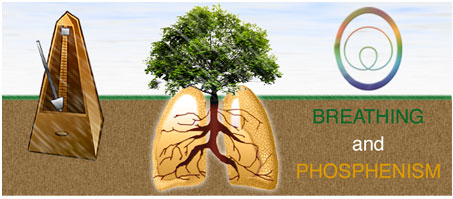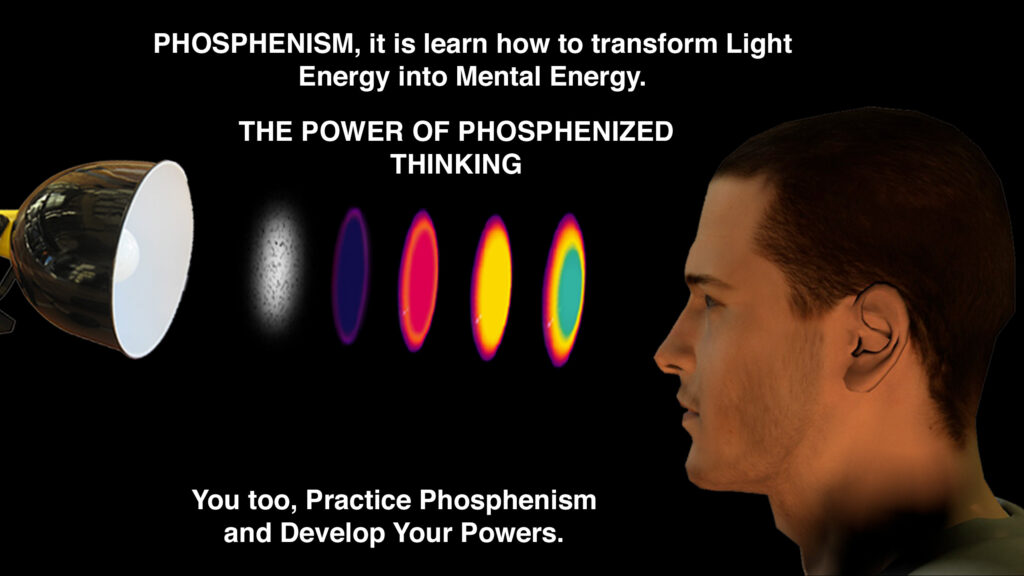BREATHING

There is no living without breathing! Breathing is one of the most important of our vital functions. It is through breathing that the blood and the brain are oxygenated. We can consciously control our breathing. A full, relaxed breathing is very beneficial for the body and the mind. Breathing can slow the rhythm of the heart, improve the oxygen levels in the blood, increase exchanges between cells. On a mental level, it calms the mind, helps controling emotions, increases concentration.
Breathing techniques go back thousands of years ago. One of the eight principles of Patanjali’s yoga is pranayama, from the sankrit prâna ‟breath” and yama ‟mastery”. The exercises of pranayama send extra energy into the brain bringing an ever increasing mental self-control.
We would like to analyse the effects rhythmic breathing in the light of the discoveries in cerebral physiology of Doctor Francis Lefebure, a French physician and researcher. Thanks to the systematic use of the phosphenes, Dr Lefebure designed a protocol of exploration of the brain: cerebroscopy, which allowed him to measure precisely the action of breathing exercises on the brain, and to create a scientifically improved yoga: Phosphenism.
The phosphenes are all the sensations of light which are not directly produced by light stimulating the retina. They can be produced by focusing shortly on sources of light.
Dr Lefebure has demonstrated that the phosphene is a reversal of the sense of sight towards the inner part of the individual. Similarly, the acouphene is a reversal of the sense of audition. Actually, there is an inner equivalent of every physical sense, forming together a second sensory system: the phenic system. Mixing thoughts with a phene is the basic exercise of Phosphenism and probably constitutes the true meaning of Prayahara or reversal of sensory activity towards the inside. There is also a phene related to breathing, it is called ‟pneumophene”, and it can be stimulated by maintaining a slight ‟thirst for air” or lack of air in the lungs.
In his 1966 book, Rhythmic Breathing and Mental Concentration, Dr Lefebure shows how breathing is related to our environement. The rhythm of our breathing is always changing, according to our environement: slow and regular when we sleep, it accelerates under the influence of emotions and, in some cases, it can even stop completely under the stressful influence of bad news. Dr Lefebure the notices that ‟of all our vegetative vital functions, breathing is the only one that we can consciously control”. Consequently, breathing establishes a connection between our psyche and the outside environement.
Insisting on the importance of rhythm, he demonstrates that rhythms amplify thoughts: ‟rhythmic breathing is the physiological state that is most favorable to certain mental activities”. By synchronizing the rhythm of thinking and the rhythm of breathing, we can transform physical energy into psychic energy.
As a physician, Dr Lefebure’s first interest was the effects of this psychic energy on illnesses. He describes a case of recovery from multiple sclerosis thanks to this method. But quickly, he started to show interest in the initiatory effects of rhythmic breathing. When it is associated to a thought, the phosphene powers it with a remarkable intensity, so does rhythmic breathing which fills thoughts with prâna, giving them an amazing density. Thanks to cerebroscopy and synchrophony, Dr Lefebure discovered the importance of the rhythm of two seconds and the role it plays in the awakening of higher abilities: intellectual, moral, psychic and spiritual.
An exercise of rhythmic breathing: square breathing
Set your metronome on 60 BPM, i.e. one beat per second.
Do a phosphene.
Breathe in for 6 seconds.
Maintain the air in your lungs for 6 seconds (Retention with lungs full).
Breathe out for 6 seconds.
Maintain your lungs empty for 6 seconds (Retention with lungs empty) .
Continue this cycle until the phosphene disappears (roughly three minutes) .
Do another phosphene and start the cycle again.
Visualize a dot of light rotating in your lungs during the phases of retention.
This value of 6 seconds is only a guideline, other values can be used, depending on the capacity of one’s lungs. It is the precise regularity of the phases that is important.
Circular breathing
Similar to square breathing, circular breathing does not, however, contain phases of retention. It is a kind of square breathing which angles would have been rounded off.
Set your metronome on 60 BPM, i.e. one beat per second.
Do a phosphene.
Breathe in for 4 seconds, starting by breathing very little and progressively increasing the flow of air.
Keep breathing in for 4 more seconds but, this time, progressively reduce the flow of air until you barely breathe in.
Breathe out for 4 seconds, starting by breathing very little and progressively incresing the flow of air that comes out of your lungs.
Keep breathing out for 4 more seconds but, this time, progressively reduce the flow of air until you barely breathe out.
During circular breathing, visualize a dot of light rotating inside your lungs or around your head, or around your body. The dot of light can follow the rhythm of breathing (one full circle in 16 seconds).
Maintain this breathing cycle until the phosphene has disappeared (approximately three minutes).
Do another phosphene and start the cycle again.
The value of 4 seconds is only a guideline, other values can be used, depending on the capacity of your lungs.
Nevertheless, we advise you to start practicing with these values as increasing the length of the phases is not the purpose of this exercise. The purpose of this exercise is to breathe with a slight lack of air.
Importante Note
We have done our best to provide you with the most accurate translation of our french website. Nevertheless, it is possible that some language errors may remain. So, don’t hesitate to contact us to communicate them to us.
Thank you for your indulgence and for your consideration of the many hours spent translating all our pages and, more particularly, all the testimonies we share with you so that you may become aware of the impact that Phosphenism can have on those who practice it.
Wishing you the best with your practice of Phosphenism.
Daniel Stiennon (Dr. LEFEBURE School Director, France)


